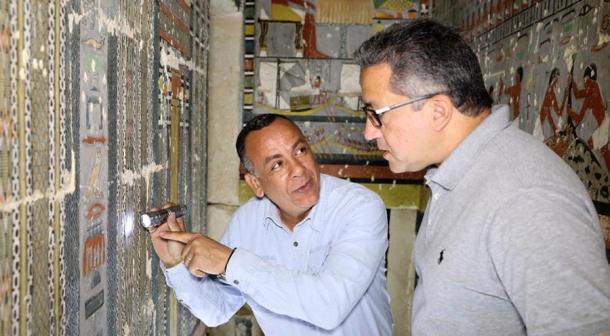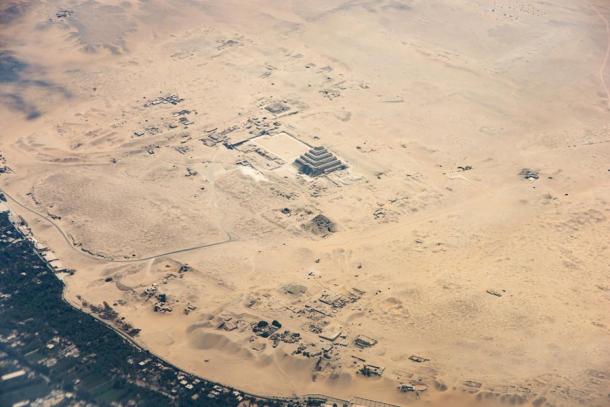Saqqara, an ancient Egyptian village in the Giza area, renowned for its massive burial ground of Egyptian pharaohs, served as the royal necropolis for the ancient Egyptian capital of Memphis. Since excavations began in the 1970s, it has become increasingly important for its pivotal role in the reconstruction of Egypt’s glorious ancient history, as well as the existence of very important pyramids. Now, an archaeological mission from Cairo University has unveiled the interior of a tomb at the Saqqara necropolis near the three pyramids of Giza, just south of Cairo, reports CGTN Africa .

The Saqqara tomb included columns carved with detailed reliefs. ( Egyptian Ministry of Tourism and Antiquities )
Ptahemwia: An Important Official Under King Ramses II
In a statement released on 30th October, 2021, the Egyptian Ministry of Tourism and Antiquities confirmed that the Egyptian tomb belonged to a very important official by the name of Ptahemwia, a civil servant under King Ramses II , who ruled between 1279 and 1213 BC. “The importance of discovering this tomb is due to the positions held by its owner, who was a royal scribe, head of the treasury, chief overseer of the cattle and also in charge of divine offerings at the temple of Ramses II (Ramesseum) in Thebes (in Upper Egypt),” said Mostafa Waziri, secretary-general of the Supreme Council of Antiquities.
While excavations at the Saqqara necropolis began in the 1970s, it was only in the 1980s when the search for royal tombs began, leading to the discovery of several tombs from the Ramesside Period . The current excavation team is being headed by Ola el-Aguizy, who has been working on the site since 2005. The entrance and interior of Ptahemwia’s tomb have now been unveiled. “What has been discovered of the tomb is its entrance built of stone carved with reliefs showing the owner of the tomb,” explained el-Aguizy. “The entrance leads to a hall whose walls have drawings painted and colored on a layer of plaster.”

The tomb of Egyptian nobleman Khuwy, where evidence discovered in 2019 showed that advanced mummification process knowledge existed 1,000 years earlier than previously thought. ( Egyptian Ministry of Tourism and Antiquities )
Recent Saqqara Discovery Sheds Light on Mummification
Just last week, Ancient Origins had reported on another fascinating discovery emanating out of the Saqqara necropolis. It appears that advanced mummification techniques were being employed a full 1,000 years earlier than previously believed, rewriting the understood history of ancient Egyptian funerary practices. The mummy in question was Khuwy, who was discovered in 2019, and was a high-ranking nobleman in the Old Kingdom, just like Ptahemwia.
This further sheds light on the mummification process used for the elite in ancient Egypt, and the pains undertaken to preserve the crème-de-la-crème of Egyptian society, who were philosophically and culturally preoccupied with the idea of the afterlife. Ultimately, the size of the graves would differ according to status and wealth. We are learning more about this complex subject, as modern-day historical reconstruction is relying less on the accounts of ancient writers, and more on the modern-day scientific methods that have made dating and DNA analysis much more efficient.

The Djoser step pyramid at Saqqara as seen from the air. ( Vladyslav Siaber / Adobe Stock)
The Importance of the Famed Saqqara Necropolis
Saqqara is also home to the world-famous step pyramid of Djoser, which was built during the Third Dynasty, i.e., 27 BC, along with the pyramids of 16 pharaohs. Incidentally, Ramses II’s son, Prince Khaemweset, made significant repairs to the pyramids and other buildings at Saqqara, including the world famous Pyramid of Unas , built by the last and final king of the Fifth Dynasty, Unas, from the 5th century BC. Perhaps, one could argue that Khaemweset’s role helped modern-day historians reconstruct a vital part of ancient history!
Saqqara is also home to what have been dubbed megatombs, meaning dozens of beautifully painted, human-shaped coffins jammed together, floor to ceiling, stacked roughly on top of heavy limestone sarcophagi. These megatombs include hundreds of coffins, mummies, and grave goods that includes art, precious gems, placing Saqqara at the center of a national revival during a period late in ancient Egyptian history, as per a report in Smithsonian Magazine . There are many interesting and exciting possibilities that are constantly emerging out of the digs at Saqqara, as we eagerly cheer on the successes of the excavation team.
Top image: The recently unveiled Saqqara tomb boasts stunning artwork on the walls. Source: Egyptian Ministry of Tourism and Antiquities
By Sahir Pandey
 RSS Feed
RSS Feed















 November 2nd, 2021
November 2nd, 2021  Awake Goy
Awake Goy  Posted in
Posted in  Tags:
Tags: 













